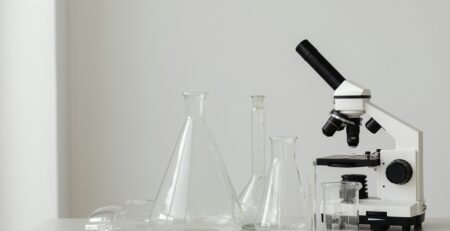1
Sep
Desiccators in the Lab: Glass vs Plastic, Vacuum vs Plain
Moisture control is critical in laboratories, especially when working with hygroscopic materials, weighing samples, or storing sensitive reagents. Desiccators — available in glass or plastic, and in vacuum or plain configurations — provide a simple yet reliable way to maintain a dry environment. Understanding the differences ensures Australian labs choose the right model for safety, compliance, and long-term value.
Why Use a Desiccator?
Desiccators protect sensitive samples from atmospheric moisture. By placing a desiccant (such as silica gel or molecular sieves) inside the chamber, they maintain a low-humidity environment ideal for storing chemicals, dried precipitates, or calibration weights. Vacuum desiccators go further by reducing internal pressure, accelerating drying and preventing oxidation.
LabChoice Australia supplies a full range of BORO 3.3 glass and polypropylene/polycarbonate plastic desiccators, offering durable solutions for both routine teaching and advanced research applications.
Desiccator Comparison Guide
| Feature | Glass Desiccator | Plastic Desiccator (PP/PC) |
|---|---|---|
| Durability | High heat resistance, long lifespan | Lightweight, shatter-resistant |
| Transparency | Clear visibility, resists scratches | Excellent clarity but may scratch over time |
| Chemical Resistance | Resistant to most solvents and acids | Resistant to many chemicals, less heat tolerant |
| Cost | Higher initial cost | More affordable, especially for teaching labs |
| Applications | Advanced research, high-temp drying | Education, routine storage, lightweight use |
| Feature | Vacuum Desiccator | Plain Desiccator |
|---|---|---|
| Function | Uses reduced pressure to speed drying | Maintains dry atmosphere with desiccant only |
| Best For | Sensitive reagents, analytical chemistry | General sample storage, teaching labs |
| Strength Required | Must be BORO 3.3 or reinforced plastic | Suitable for lighter, everyday applications |
| Cost | Higher due to reinforced design | More economical |
When to Choose Glass vs Plastic, Vacuum vs Plain
- Glass Vacuum Desiccator: Ideal for advanced research, chemical analysis, and storage of highly sensitive compounds. Example: A Sydney QC lab uses LabChoice BORO 3.3 vacuum desiccators to preserve pharmaceutical standards with ISO-compliant accuracy.
- Plastic Plain Desiccator: Perfect for classrooms and general storage. Melbourne schools use LabChoice polypropylene desiccators for storing hygroscopic salts during student experiments.
- Glass Plain Desiccator: Combines durability with moderate cost, suitable for daily use in research and teaching labs.
- Plastic Vacuum Desiccator: Lightweight alternative for labs needing reduced pressure without heavy glass.
FAQs
Can desiccators be autoclaved?
BORO 3.3 glass and some polypropylene models can withstand autoclaving, but always check manufacturer guidelines.
Do I always need a vacuum pump with a vacuum desiccator?
Yes, vacuum desiccators require an external pump, but plain types only need a desiccant.
Which desiccant should I use?
Silica gel is most common, but molecular sieves are recommended for ultra-low humidity.
Are plastic desiccators safe for strong acids?
Polypropylene and polycarbonate handle many chemicals but are less resistant to strong oxidisers compared to glass.
📚 References
Standards & Specifications
- ISO 13121-1:2021 – Nanotechnologies — Labelling of manufactured nano-objects and products containing them — Part 1: General requirements (covers lab safety practices for moisture-sensitive materials). International Organization for Standardization.
https://www.iso.org/standard/78988.html - ASTM E104-02(2012) – Standard Practice for Maintaining Constant Relative Humidity by Means of Aqueous Solutions. ASTM International (relevant for desiccator humidity control).
https://www.astm.org/e0104-02r12.html - ASTM D4236-94(2021) – Standard Practice for Labelling Art Materials for Chronic Health Hazards (includes chemical storage and safety handling guidance relevant to desiccators). ASTM International.
- ASTM E145-94(2020) – Standard Specification for Gravity-Convection and Forced-Ventilation Ovens (referenced for drying processes linked with desiccator use).
Academic & Safety Guides
NIST (National Institute of Standards and Technology) – Use of Desiccators in Maintaining Reference Standards. NIST Handbook.
https://www.nist.govation, budget, and safety needs. Glass vacuum desiccators provide precision and durability for research, while plastic plain models offer affordability and convenience for education. LabChoice Australia delivers a full range of BORO 3.3 glass and polypropylene desiccators, ensuring Australian labs can maintain sample integrity with confidence.
American Chemical Society (ACS) – Safe Storage Practices: Use of Desiccators in Chemical Laboratories. ACS Laboratory Safety Resources.
https://www.acs.org/safety
CSIRO – Laboratory Glassware Safety Guide – Safe Use of Vacuum and Plain Desiccators in Research. CSIRO, Australia.
https://www.csiro.au
University of Melbourne – Faculty of Science – Undergraduate Laboratory Manual: Moisture Control with Glass and Plastic Desiccators. Melbourne, Australia.

